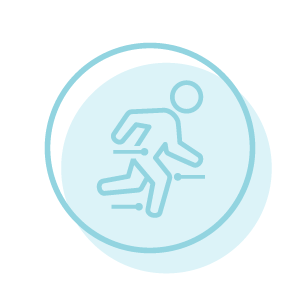What is hip osteoarthritis?
The hip joint is a ball and socket joint and has a protective cartilage cushion which helps to evenly distribute forces throughout the hip joint. By far the commonest type of arthritis to affect the hip is osteoarthritis which is a degenerative condition which often results from progressive wear of the hip.
What can cause it?
Osteoarthritis is often due to age-related wear of the cartilage in the hip. It may have an associated family history/genetic component, or secondary to a condition such as osteonecrosis, previous trauma, childhood hip disorders or a previous infection of the hip.
It can also be secondary to a systemic condition such as diabetes and rheumatoid arthritis. A history of heavy lifting or repetitive loading of the hip can also cause osteoarthritis. Being overweight is also a risk factor.

What are the symptoms and signs?
Symptoms can comprise a broad spectrum which can range from an intermittent mild activity-related groin ache through to more significant constant pain involving the groin, buttock, lower back and the ipsilateral knee joint. The pain from an arthritic hip rarely radiates beyond the knee joint. If there is radiation beyond the knee joint towards the foot one would certainly have to exclude a spinogenic cause. As the disease process progresses, one’s analgesic requirements often increase and mobilisation distance decreases.
Hobbies and activities of daily living, such as donning your own shoes and socks, bath transfer and performing one’s own pedicure gradually become more and more compromised as one’s quality of life diminishes. There may be associated symptoms such as clicking, grinding or giving way.
Objective signs in the office may include: an associated limp or a waddle as the patient walks; on the couch there is often a significant reduction in the range of motion of the hip joint and as the disease process progresses the hip can become quite irritable with pain being reproduced with even a small amount of internal rotation. The soft tissue envelope along with the nerve and vascular supply of the limb is always routinely assessed.

What investigations may be required?
Investigations help confirm the diagnosis, grade the severity of the condition and where applicable, aid in pre operative planning.
Plain radiographs are a quick and effective way of confirming arthritis in a joint. In the early stages when there is inflammation with no damage to the joint they may be normal. Most people, however, present when there is some structural damage.
X-rays are taken centred on the hip from both the front and the side. On occasion, further tests, including an ESR/CRP to exclude significant infection or inflammation, are performed but often the diagnosis of hip osteoarthritis is readily made from x-rays alone.
The following are features of arthritis on a plain radiograph:
- Decreased joint space
- Subchondral sclerosis
- Subchondral cysts
- Osteophytes
- Deformity
Can the problem get worse?
The problem can certainly progress and therefore careful clinical and x-ray monitoring is important.
Potential complications
It should be borne in mind that complications may result from a condition with or without surgery. Complications of non-operative treatment include: worsening pain, increased stiffness, increasing deformity, adjacent joint disease, pain elsewhere, for example in knee, hip or lower back (due to abnormal gait and compensatory mechanisms). Complications can occur with any type of surgery.
Potential general complications: risks and complications of anaesthesia, bleeding, infection, blood clots, failure to fully correct a deformity, the need for further surgery, persistent pain, complex regional pain syndrome and wound healing problems, genito-urinary and cardiovascular complications.
Potential complications which are specific to the surgery mentioned above include:
Nerve damage/foot drop, intraoperative fracture, stiffness, instability/dislocation, loosening, wear, leg length discrepancy, the need for revision surgery, non-resolution of symptoms and partial resolution of symptoms.
If develop sudden onset of chest pain, breathlessness/ breathing changes or sweating please call 999 immediately since this could be an undetected clot which has travelled to the lungs. This is an emergency and requires immediate treatment. This is a very rare complication.
Treatments
There is no one treatment that has a reliably successful, quick and easy cure for arthritis. Therefore researchers and doctors are constantly looking for new and better ways of treating arthritis.
Many treatments have come into fashion and then gone away over the years once results had shown that the initial promise was premature and misplaced.
At The London Hip and Knee Clinic we do not promote or discourage new treatment options for arthritis. We would, however, advise a cautious approach to relatively untested treatment modalities with little or no evidence to back their use. Patients undergo these treatments at their own risk.

Non-surgical management
These include activity modification, painkillers, physiotherapy, the use of a walking stick, hip joint steroid injection.
Non-operative management for hip osteoarthritis aims at relieving pain and return to full activity whenever possible. It is likely to be most effective in the early stages of the condition.
It should always be the first line of treatment. Options include:
Activity modification. A period of rest from sports and exercise that bring on symptoms. Avoiding high impact activities with lots of turning and twisting.
Non steroidal anti-inflammatories. The use of non-steroidal anti-inflammatory drugs (NSAIDs) can decrease discomfort in patients with hip arthritis by reducing inflammation in the joint.
Analgesics. The use of paracetamol and other painkillers to help reduce pain levels.
Physiotherapy. Physiotherapy works by strengthening muscles around not only the joint but the whole kinetic chain. Results are variable with arthritis and depend really on the severity of the disease. In a very stiff and damaged joint, physiotherapy may make your symptoms worse. Your surgeon will guide you.
Walking aids. The use of a walking stick or cane to reduce the forces going across the damaged joint.
Weight loss. Can relieve the pressure on painful damaged joints.
Dietary supplements. These are increasingly popular with people who have arthritis. The cartilage found in joints, normally contains glucosamine and chondroitin. It is thought that taking supplements of these natural ingredients may help to improve the health of damaged cartilage.
Research has provided mixed results but on the whole suggests that glucosamine sulphate is more likely to be helpful than glucosamine hydrochloride. If you notice no improvement in your symptoms after 3 months then you should probably discontinue it. If you do find it improves your symptoms then you should continue taking the supplements. There is no extra benefit in taking glucosamine and chondroitin.
Remember that supplements also have side effects and it is advisable to discuss with your GP before starting any new treatment.

Surgical treatment
There is no doubt a total hip replacement is the operation of the century. It is one of the top three interventions that can be performed in any branch of medicine including cataract surgery and renal transplantation surgery.
Furthermore, the hip replacement patient demographic is changing. People are now living longer and, as a consequence, more and more people are wearing out their native hip joints and are requiring intervention in the form of hip replacement surgery.
However, on the other end of the spectrum, we are seeing a rise in the number of younger patients requiring joint replacement surgery. The exact cause of this rise is unknown. Is the unhealthy lifestyle created by modern living causing us to wear out our joints quicker through intense fitness regimes?
Total hip replacement involves surgically removing the worn down cartilage and neighbouring bone and replacing it with artificial components. Significant biotechnological advances have now led to the formation of state-of-the-art hip replacement designs.
These often involve press fitted biological fixation into the host bone along with ceramic on ceramic/ highly cross-linked polyethylene bearing surfaces. These high-performance designs have revolutionised the treatment of end-stage arthritis in all age groups.
Whatever your age, it is important to remember that you do not need to suffer constant pain and misery as a result of hip arthritis. Total hip replacement design has become significantly advanced and it is now one of the most successful operations performed with excellent outcomes.
Postoperative period and recovery
Remember that below is a guide to recovery and that everyone heals at different rates and some people do take longer. Use this information to help you understand your condition, possible treatment and recovery. The timeframes given below are a minimum, it is important that you appreciate this when considering surgery as your healing and recovery may take longer.
After your operation, a routine enhanced programme of recovery will commence. The main parallel work streams of this programme are as follows:
